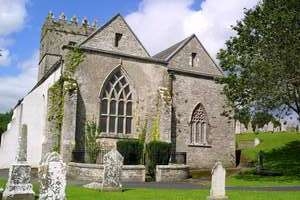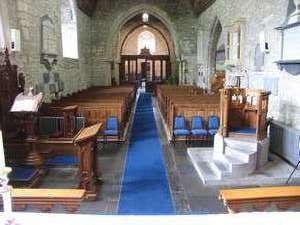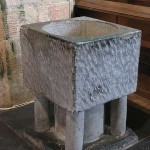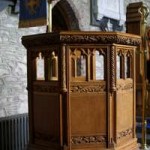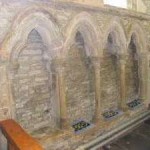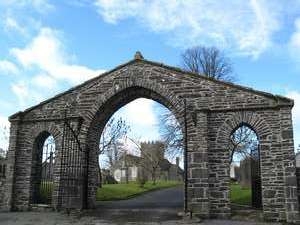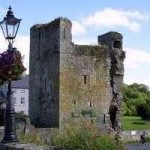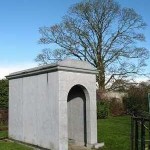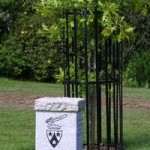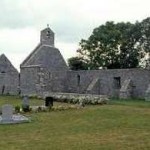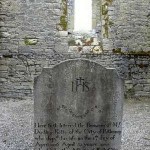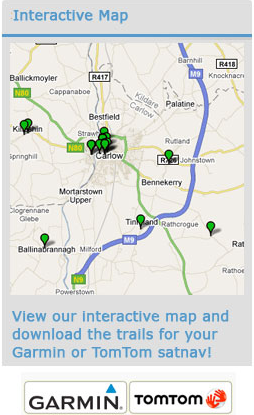Sites
Old Leighlin – Seanleithghlinn
The picturesque village of Old Leighlin is home to one of Ireland’s gems of late medieval architecture. 1. St. Laserian’s Cathedral, Carlow’s oldest working building, was built on the site of a monastery founded by St. Gobban c. 600. St. Laserian (Lasrain or Mo-Laise) became abbot c. 620 and the settlement grew to eventually accommodate some 1,500 monks.
2. The holy well which can be found 100 metres west of the church is dedicated to St. Molaise and features an early ringed cross said to denote the place where St. Laserian conversed with St. Finbar of Cork. Laserian, who was originally from Ulster, is celebrated for the Synod held in Leighlin in 630 at which the Irish Church adopted the Roman method for arriving at the date of Easter.
In 1111 Leighlin was constituted a diocese and thereafter the church here assumed cathedral status. The present building was started by Bishop Donatus (1152-85) and continued under his successors. Much of the fabric dates from the twelfth and thirteenth centuries. The tower dates from the late fifteenth century, while the Lady Chapel was attached to the north side of the choir![]() in the sixteenth century. The church consisted of the long chancel
in the sixteenth century. The church consisted of the long chancel![]() and nave
and nave ![]() of the present building with transepts to the north and south. No trace of the south transept survives and the north is present in an unroofed state.
of the present building with transepts to the north and south. No trace of the south transept survives and the north is present in an unroofed state.
St. Laserian’s Cathedral features architecture from every century since it was built. The stone interior of this beautifully preserved church is illuminated by large Gothic![]() style windows and a magnificent stained glass window behind the altar. One of the glories of the cathedral is the intricate ribbed vault of the crossing
style windows and a magnificent stained glass window behind the altar. One of the glories of the cathedral is the intricate ribbed vault of the crossing ![]() tower. The beautifully carved sedilia
tower. The beautifully carved sedilia ![]() reflect the cathedral status of this building. This is one of the few churches in Ireland that has four seats, rather than the usual three. It is suggested that the fourth seat was for the Bishop. Cathedrals normally provided a special chair for the bishop but Old Leighlin may have just provided a place on the sedilia.
reflect the cathedral status of this building. This is one of the few churches in Ireland that has four seats, rather than the usual three. It is suggested that the fourth seat was for the Bishop. Cathedrals normally provided a special chair for the bishop but Old Leighlin may have just provided a place on the sedilia.
There are two fonts in the church, both of which are older than the building. The earlier font consists of a massive piece of Kilkenny marble, hollowed with rough hand tools. The other font known as the Gowran font is more decorative.
There are some fine nineteenth century pieces in the cathedral. The Bishop’s throne is richly carved as is the timber lectern in the traditional form of an eagle. This lectern was made in memory of Thomas and Sophie Vigors. The Vigors family of Burgage, Leighlinbridge was closely associated with the church and there are thirty two memorials to the family throughout the building. The east window designed by Catherine O’Brien, is a beautiful memorial, depicting Saints Moling, Bridget, Fiach, Canice, Patrick, John, Paul and Laserian.
There are several interesting floor tombs and the O’Byrne altar tomb (1569) opposite the south door has unusual iconography.
DID YOU KNOW
The date on which Easter is celebrated has always been a cause of difficulty and disagreement throughout Christian history. The main Latin churches throughout Western Europe used the Roman system of prediction. In the seventh century the less accurate Celtic system was in use in Ireland. This caused unnecessary dissent and St. Laserian overcame the problem persuading the Irish Bishops gathered in the Synod of 630 to adopt the Roman system. This was no mean feat given the Irish church’s tradition of independence in thinking and practice but it greatly helped in unifying the church. This achievement was confirmed for the Western Church at the Synod of Withby in 664 A.D.
 Open : end May – end September, Tuesday – Saturday 11 a.m. – 4.00 p.m. or by arrangement. T: 059-972 1570, Guide available on request.
Open : end May – end September, Tuesday – Saturday 11 a.m. – 4.00 p.m. or by arrangement. T: 059-972 1570, Guide available on request.Admission: Free
Parking: Yes
![]() Choir: Part of a church commonly occupied by singers, situated between the nave and the chancel.
Choir: Part of a church commonly occupied by singers, situated between the nave and the chancel.
![]() Chancel: The eastern part of a church, usually where the main altar is situated.
Chancel: The eastern part of a church, usually where the main altar is situated.
![]() Nave: The main aisle of a church, occupied by the congregation.
Nave: The main aisle of a church, occupied by the congregation.
![]() Gothic: Style of architecture, originating in the middle ages, characterised by pointed arches. When used in more recent times, it is described as neo-Gothic or Gothic revival.
Gothic: Style of architecture, originating in the middle ages, characterised by pointed arches. When used in more recent times, it is described as neo-Gothic or Gothic revival.
![]() Crossing: The intersection of transepts and nave.
Crossing: The intersection of transepts and nave.
![]() Sedilia: Seats for clergy on the south side of the chancel, often located in niches.
Sedilia: Seats for clergy on the south side of the chancel, often located in niches.
St. Laserian’s Cathedral
St. Laserian’s Cathedral
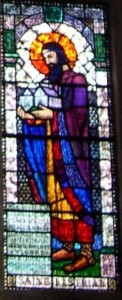 St. Laserian’s Trail covers the mid-Carlow area, featuring a number of sites of national significance including the medieval Cathedral at Old Leighlin as well as the impressive Adelaide Memorial Church at Myshall. Enjoy discovering these ancient sites, tucked away in green valleys or up high on open countryside surrounded by an expanse of sky. Perhaps a moment of quiet contemplation will provide insights into the secrets and mysteries contained within.
St. Laserian’s Trail covers the mid-Carlow area, featuring a number of sites of national significance including the medieval Cathedral at Old Leighlin as well as the impressive Adelaide Memorial Church at Myshall. Enjoy discovering these ancient sites, tucked away in green valleys or up high on open countryside surrounded by an expanse of sky. Perhaps a moment of quiet contemplation will provide insights into the secrets and mysteries contained within.
St. Laserian, sometimes called Molaise, was the founder of the See of Leighlin and its first bishop. He was born about the year 566. He studied in Rome and was sent to preach the word of God in Ireland. In fulfillment of this mission, Laserian visited many parts of Ireland including Leighlin.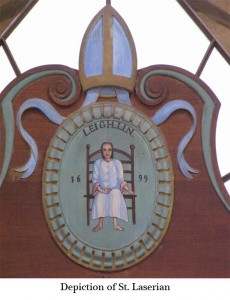
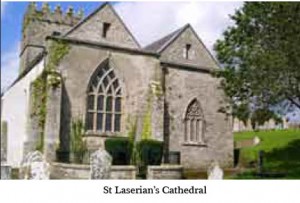
Did You Know…
The date on which Easter is celebrated has always been a cause of difficulty and disagreement throughout Christian history. The main Latin churches throughout Western Europe used the Roman system of prediction. In the seven th century the less accurate Celtic system was in use in Ireland.
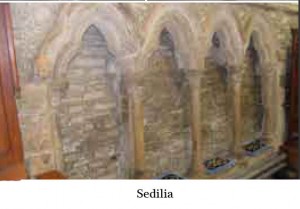
This caused unnecessary dissent and St. Laserian overcame the problem persuading the Irish Bishops gathered in the Synod of 630 to adopt the Roman system.
This was no mean feat given the Irish church’s tradition of independence in thinking and practice but it greatly helped in unifying the church. This achievement was confirmed for the Western Church at the Synod of Whitby in 664 A.D
The holy well
2. The holy well
The holy well which can be found 100 metres west of the church is dedicated to St. Molaise and features an early ringed cross said to denote the place where St. Laserian conversed with St. Finbar of Cork. Laserian, who was originally from Ulster, is celebrated for the Synod held in Leighlin in 630 at which the Irish Church adopted the Roman method for arriving at the date of Easter.
Leighlinbridge – Leithghlinn an Droichid
The attractive village of 3. Leighlinbridge lies along the banks of the River Barrow with beautiful riverside walks and a tradition of gardening that comes alive each year for the national Tidy Towns Competition and the Carlow Garden Festival.
In the Garden of Remembrance spend some time looking at the memorial stones to the Carmelite order and to the Sisters of Mercy. There are plaques to Brian Mulroney, Prime Minister of Canada (1984–1993) whose family hailed from the area, John Tyndall and Nicholas Vigors. Visit Ireland’s first all county World War 1 memorial, listing the men from Carlow who died in the Great War.
The Sculpture Garden is dedicated to three of Leighlinbridge’s most famous sons – Cardinal Patrick Francis Moran – Australia’s first Cardinal (see St. Molings Trail), John Tyndall, the scientist and mountaineer (see St. Patrick’s Trail) and Captain Myles Keogh (see St. Patrick’s Trail). Keogh was second in command to General Custer and lost his life in the Battle of the Little Big Horn in 1876 at the hands of the Sioux Indians.
DID YOU KNOW
In 2001 Leighlinbridge won a gold medal in the European Entente Florale Competition, the first Irish village to do so in twenty five years. The award is in the Garden of Remembrance.
Admission: Free
Parking: Yes
Wells medieval parish church
4. Few medieval parish churches have survived in Carlow and Wells must have been one of the largest. Medieval sources refer to the parish church of Wells in 1262 and the visible remains date to this period although they have been restored in more recent times.
Walking around the ruins one can trace the impressive form of a long nave![]() and chancel
and chancel![]() church built with limestone rubble and granite ashlar
church built with limestone rubble and granite ashlar![]()
The east and most of the south wall survive along with the reconstructed north wall of the nave. There are two tall, narrow, round-headed lights in the south wall.
In the late-medieval or the early- modern period the nave appears to have been abandoned and a single bellcote was placed over the smaller eastern space. The chancel has a large window with dressed stone in the north wall. There is also a double piscina with canopy. The church is surrounded by an enclosed and well-maintained graveyard which is still in use today.
Admission: Free
Parking: Yes
![]() Nave: The main aisle of a church, occupied by the congregation.
Nave: The main aisle of a church, occupied by the congregation.
![]() Chancel: The eastern part of a church, usually where the main altar is situated.
Chancel: The eastern part of a church, usually where the main altar is situated.
![]() Ashlar: Masonry comprised of squared stones.
Ashlar: Masonry comprised of squared stones.
